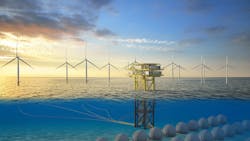Pleuger Industries advances subsea energy storage solution
Pleuger Industries, a developer of submersible motor pump technologies, says that it is working to help advance a subsea energy storage system. The work is part of the StEnSea (Stored Energy in the Sea) project.
Since the project’s early development in 2012, and in partnership with Fraunhofer IEE and Sperra, Pleuger says that its background in submersible pump systems is helping facilitate a new era of renewable energy storage solutions.
The StEnSea project, initially conceived by the German Fraunhofer Institute, seeks to revolutionise long-duration energy storage by adapting the principles of pumped storage hydropower for subsea environments.
The project is said to utilize a novel approach to energy storage by placing hollow concrete spheres on the seabed at depths of 600 to 800 meters. When electricity demand is low, these spheres are emptied of water using Pleuger’s specially designed submersible pumps to store potential energy.
During peak demand, water is allowed to flow back into the spheres, turning the pumps into turbines that generate electricity. This method is said to mirror the functionality of traditional pumped storage hydropower but adapts it for the subsea environment, leveraging ocean pressure to store and release energy efficiently.
A comprehensive GIS analysis of coastal marine areas has revealed numerous potential locations for deploying this technology globally, including off the coasts of Norway, Portugal, the US East and West Coasts, Brazil, and Japan.
Pleuger says that this initiative addresses the need for scalable, efficient energy storage solutions that can integrate renewable energy sources, stabilize power grids, and reduce reliance on fossil fuels.
By leveraging its custom pump systems, the project is set to deliver a groundbreaking, modular subsea pumped hydroelectric storage system that stores energy invisibly beneath the ocean’s surface.
Pleuger says that the StEnSea project has received substantial financial backing from both the US and German governments, highlighting its significance and the confidence of its potential global impact.
Pleuger says that it has been involved with the StEnSea project since its inception, contributing to the development of the first prototype with a specially designed underwater pump.
Now, with “substantial” funding and international partnership, the project is scaling up to include a 10-meter prototype capable of generating 0.5 MW of power at depths exceeding 600 meters.
